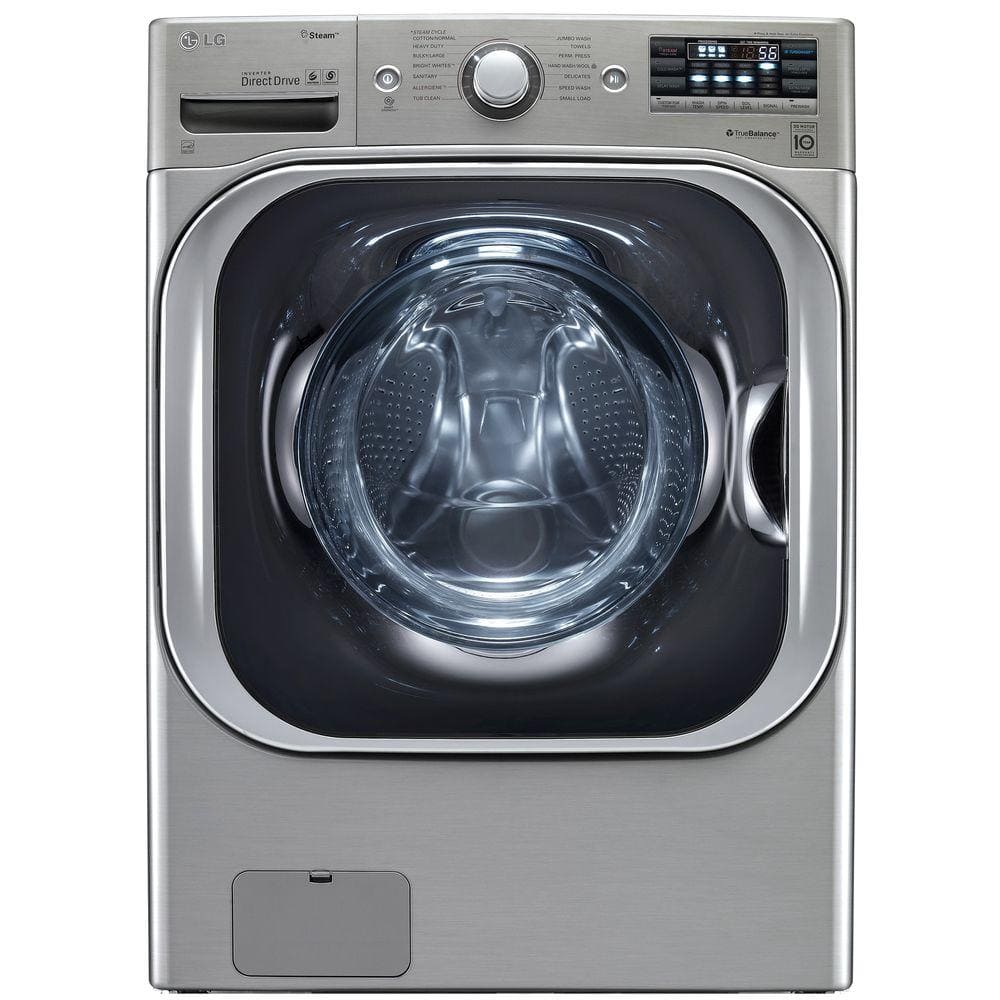LG 5.2 cu. ft. HE Mega Capacity Front Load Washing Machine with Steam and TurboWash in Graphite Steel, ENERGY STAR
Save up to 30 minutes per load with new LG TurboWash Technology. Pairs best with LG Electric DLEX8100V or Gas DLGX8101V Dryer(s). Stackable w/ LG washer/dryer set & SideKick pedestal compatible.
Imagine being able to wash a king size comforter and a full set of bedding in a single load. And just think how much more amazing this would be if you could tackle a regular load of laundry 20 minutes faster. Stop imagining and go for it. LG takes the industry’s largest capacity washer and powers it to the max with time-saving TurboWash technology and a steam cleaning feature that virtually eliminates dirt, wrinkles and odors.
- The largest capacity washer available at 5.2 cu. ft., you can fit a comforter and full set of king size bedding in a single load
- Electronic control panel with dual LED display and dial-a-cycle makes selecting the right easy
- LG’s revolutionary Turbowash technology allows you to wash larger loads 20 minutes faster, with outstanding cleaning performance
- Awarded the 2015 ENERGY STAR most efficient designation
- Each wash cycle combines up to 6 different wash motions to provide a revolutionary cleaning experience with 6Motion technology
- 14 wash cycles, including AAFA- Certified Allergiene, NSF-certified sanitary and hand wash/wool
- Cold wash technology uses cold water and enhanced washing motions to deliver cold-water saving with a warm-water performance
- Saving energy doesn’t have to mean compromising on cleaning with the ColdWash option; powered by the LG Direct Drive Motor and 6Motion technology, it’s ideal for cleaning all types of clothes – even those you normally wash in warm water; can be used with almost any wash cycle and virtually all fabric types
- Steam technology deeply penetrates fabrics to know out dirt and reduce wrinkles and odors while it also uses less water than traditional washers, so you won’t take a bath on your bills
- Allergiene cycle helps remove more than 95% of common household allergens, including dust mites and pet dander, helping to improve clothing hygiene
- Truebalance anti-vibration system is designed to minimize washer vibration for smooth, quiet performance in any room of the house – even on the 2nd floor
- The sense clean wash system sets the water and wash time automatically based on the weight and size of each load for optimal washing care
- Washer requires use of only high-efficiency detergent, typically two tablespoons per load
- The Home Depot will not hook up your washer with used fill hoses; new fill hoses will be offered during appliance checkout
- ENERGY STAR qualified to meet or exceed federal guidelines for energy efficiency for year-round energy and money savings
- Inverter DirectDrive Motor is backed by a 10-year limited warranty
- Capacity to wash as many items of clothing as the tub allows; as long as the lid shuts and locks, it will wash
- LG offers a lifetime warranty on the drum. All compatible LG washers, dryer, SideKick pedestal washers, and laundry pedestals sold separately
- Stackable design lets you stack the washer with matching dryer and optional stacking kit (not included) for a complete laundry set-up
Additional information
| Capacity - Washer (cu. ft.) | 5.2 |
|---|---|
| Depth With Door Open 90 Degrees (In) | 57.5 |
| Door Opening Height x Width (In.) | 16.93 x 16.93 |
| Product Depth x Height x Width (in.) | 32.88 x 40.75 x 29 |
| Certifications and Listings | Energy Star,UL Listed |
| Manufacturer Warranty | 1 Year Warranty: Parts and Labor, In-Home, 10 Years: Direct Drive Motor, Limited Lifetime: Stainless Steel Drum |






by Richard
Have always liked LG products.
by Elaine
I love how big this washing machine is! I can fit a larger than king size comforter in it no problem! Quick wash cycles. Easy to use interface. I’m a fan.
by John
By far the best LG washer and dryer I’ve owned. I am loving the larger size and color is nice too.
by Karen
Machine is excellent and delivery setup was also excellent! We are in an old house and nothing ever goes according to plan.
by Mindy
It’s huge! I love it’s big size!
by Rick
Nice, lots of settings only used a couple.
by Rick
Tide pods don’t work in the drawer, where the liquid goes.